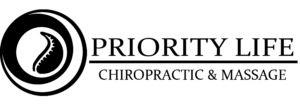Chiropractic From Head to Toe: Upper Back Pain
Although injuries to the upper back (thoracic spine) are not as common as lower back or neck injuries, there are still a number of conditions and factors that can contribute to pain and discomfort
in this area. Thankfully, your chiropractor knows how to ease your pain!
The thoracic spine is that area of your back where the ribs are attached—also called your upper back. Because of its location, the upper back and ribcage are designed to be more stable, creating a protective “cage” for many of your vital organs—like the heart, lungs, liver, stomach and spleen. Since the thoracic vertebrae do not have the same range of motion as the cervical or lumbar vertebrae, it is rare for someone to experience a disc herniation in this area.1 In fact, only about 1-3% of all disc herniations occur in the thoracic spine. Even when present, thoracic disc herniations do not necessarily cause symptoms in the person who has them! So, what causes upper
back pain?
Most of the pain felt in this region is caused by muscle and/or facet joint irritation. Many very important postural muscles are found in the upper back and will attach to the vertebrae in this area. Notably are the muscles that control shoulder stability—like the rhomboids and trapezius muscles. In addition, the postural muscles that support the head and neck in a vertical position will find their anchor points in the thoracic spine. These muscles are
collectively known as the erector spinae.
Whenever a person’s posture deviates away from the center of gravity, such as when the head is held forward or the shoulders rounded (two of the most common postural faults), this will put a large compressive load on the joints
between each vertebra (the facet joints), leaving them prone to feeling the stress and strain. Also, any minor spinal misalignments (subluxations) begin to feel like major ones when
there is any abnormal muscle tension in the area! Pain sensitive structures like joint capsules, ligaments and neighboring nerves can all be irritated by this phenomenon.
In addition, where each rib attaches to the spine, there is a set of 3 joints collectively called the costovertebral joints. Since these are functionally movable joints like any other in the body, this means they are also subject to the same stress and strain that other joints experience and they can also subluxate when put under an abnormally high or sudden load. You’ve heard the expression, “I have a rib out”? This can be a very painful condition where you feel a sharp, stabbing pain on either side of the spine. It may be difficult or painful to take a deep breath, and laying on your back with pressure directly on this area may also be painful.
No matter whether the joint that is irritated belongs to the vertebra or the rib, your chiropractor knows exactly what to do to set things right. You guessed it—the chiropractic adjustment!
With the application of this skilled and precise maneuver, the irritated joint can be re-aligned to sit properly, taking the pressure off the sensitive structures that surround the joint (capsule, ligament or nerve).
Regardless of which joint it is, once freed from restriction and misalignment, the physiological cascade called “healing” can begin: sometimes the relief from pain is immediate and dramatic; other times it takes a few days for the positive effects of the adjustment to kick in. However, rest assured the adjustment always initiates healing. When the vertebral subluxation is reduced, muscle tension around the joint will also be improved.
![image_thumb[1] (7)](https://prioritylifechiro.com/wp-content/uploads/2015/12/image_thumb1-7.png)
However, sometimes extra procedures should be specifically applied to the muscles to create ease and balance in the muscular system. Massage techniques that focus on tight muscles
in the area of symptoms have also been shown to reduce pain,4 enhancing the already positive effects granted by the chiropractic adjustment.
Finally, if the stress and strain on the upper back is caused by weak postural muscles, exercising and stretching will also be recommended as an effective tool to support your proper spinal
alignment long-term.5 Many chiropractors are well-versed in the protocols of posture correction and others rely on allied professionals to help instruct their patients in these areas. Discuss what your best options are with your chiropractor.
With chiropractic adjustments and advice, upper back pain can be lifted from your shoulders.
